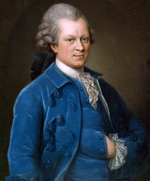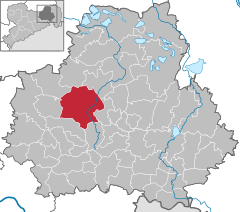|
Kamenz
Kamenz (German: [ˈkaːmɛnts] ⓘ) or Kamjenc (Sorbian, pronounced [ˈkamʲɛnts]) is a town (Große Kreisstadt) in the district of Bautzen in Saxony, Germany. Until 2008 it was the administrative seat of Kamenz District. The town is known as the birthplace of the philosopher and poet Gotthold Ephraim Lessing and Bruno Hauptmann, convicted kidnapper of the Lindbergh baby. It lies north-east of the major city of Dresden. Geography This small town is located in the west of the Upper Lusatia historic region (West Lusatia), about 40 km (25 mi) northeast of Dresden and about 30 km (19 mi) northwest of Bautzen. Situated on the Black Elster river, between the West Lusatian Hills and the Lusatian Highlands rising in the south, the town was built on greywacke and granite rocks which were mined here for centuries. Kamenz railway station is the terminus of Lübbenau–Kamenz and Kamenz–Pirna railway lines. It is served by Regionalbahn trains from Dresden Hauptbahnhof, operated by the Städtebahn Sachsen. The Hutberg hill west of the town centre, at an elevation of 293 m (961 ft), is the site of an extended landscape park laid out in 1893. It is known for its major rhododendron and azalea collections flowering at Pentecost. In 1864 the Lessing Tower was erected on the hilltop, offering a panoramic view over the West Lusatian lands and the Upper Lusatian Heath and Pond Landscape in the north. About 32% of the nature in former Kamenz District is under protection, including a network of routes for riding by bicycle and hiking. DivisionsThe town Kamenz consists of Thale Kamenz and the following Ortschaften or municipal divisions:[3]
HistoryThe settlement arose in the late 12th century, when a fortress was erected at the location of today's old town, in order to secure the junction of the medieval Via Regia trade route with the Black Elster river. From here, the Via Regia offered important transport links from the Low Countries up to Silesia. In 1225, written records first mentioned the town; Kamenz became an independent city in 1319, when Holy Roman Emperor Louis IV enfeoffed the West Lusatian lands to the Luxembourg king John of Bohemia. In 1346, the citizens joined the Lusatian League for protection against robber barons and to maintain public peace (Landfrieden). The town was nevertheless besieged and finally occupied by Hussite forces in 1429,[4] who also devastated the nearby town of Wittichenau before they marched against Bautzen. In 1469, along with the Lusatian League, the town recognized the rule of King Matthias Corvinus and passed to Hungary, and in 1490 it returned to the Czech Crown, then under the rule of Polish Prince Vladislaus II.[5] In 1493, King Vladislaus II of Bohemia had a Franciscan monastery established north of the Kamenz town walls, dedicated to Saint Anne in 1512.  Kamenz citizens officially turned Protestant in 1536. In the Schmalkaldic War of 1546/47, the Upper Lusatian towns refused to support the troops of the Habsburg emperor Ferdinand I against the Protestant princes and were penalised with the loss of numerous privileges. The Franciscan convent finally dissolved in 1564. With the 1635 Peace of Prague, the Lusatias passed from the Bohemian Crown to the Electorate of Saxony. Several witch-hunts are documented in the 17th century. In 1707 a fire destroyed large parts of the old town. A second major fire on 4 and 5 August 1842 destroyed much of the city. In 1896, Kamenz became garrison town of the Königlich Sächsisches Reserve-Infanterie-Regiment Nr. 242, part of the German 53rd Reserve Division. During World War II a subcamp of Gross-Rosen concentration camp was located in the town from 1944 to 1945, where forced labourers worked for a Daimler-Benz aircraft engine factory.[citation needed] The airfield northeast of the town was used by Luftwaffe Schlachtgeschwader 2 and Sturzkampfgeschwader 77 units. After the war, the town became part of the Soviet occupation zone and East Germany. Until 1990, an officer candidate school of the East German Air Force Staff (Offiziershochschule Franz Mehring) was located at the Kamenz Airfield. The former municipality Schönteichen was merged into Kamenz in January 2019. Politics
 Seats in the city council (Stadtrat) as of 2014 local elections:
Twin towns — sister citiesKamenz is twinned with: Sights Theatre
Museums
Buildings
Events
Notable people
References
External linksWikimedia Commons has media related to Kamenz.
|
||||||||||||||||||||||||||||||||||||||||||||||||||





